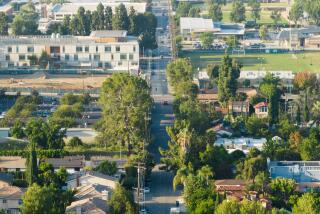Readers React: Many L.A. neighborhoods are already living the YIMBY nightmare
To the editor: In “To overcome its housing crisis, California needs YIMBY to become the new NIMBY,” Bill Boyarsky never says he is OK with a 10-story apartment building rising next to his house. He says it makes sense to rezone single-family neighborhoods to higher-density apartments when they are located within a quarter-mile of bus stops or a half-mile from train stations, as Senate Bill 50 proposes.
Los Angeles already has this policy in place through Transit Oriented Communities. In my Mid-City neighborhood, nine multistory projects are going up. Our ethnically diverse single-family homeowners now find that their hard-earned lifetime investments may abruptly lose value.
The “Yes In My Backyard” movement” — who is paying for this lobbying effort? Ordinary working people, or well-heeled developers and their political allies?
Rachel Dominguez, Los Angeles
..
To the editor: Boyarsky’s piece arrived like a fresh breeze, scattering away dried-up arguments against any new housing in Los Angeles and bringing a bracing moral clarity to a murky issue.
He’s right that older, whiter people have benefited from rising home values, while poorer and non-white folks have paid the price of excruciating housing costs. More housing — especially around transit — could make a major dent in the affordability crisis, even while leaving most single-family areas largely intact.
How uplifting at last to hear such a prominent and eloquent voice suggesting that those of us who have lived the California dream could make space for those who are now embracing it.
Fred Zimmerman, Santa Monica
..
To the editor: Boyarsky presents an incomplete view of SB 50, which would allow large apartment buildings to be built near transit corridors as defined by the act.
Such buildings could have as few as half a parking space per unit. The act defines a transit corridor as one with bus service every 15 or 20 minutes during peak periods. But nowhere in the act is there any requirement that the local transit authority maintain that bus service for any specified period.
A developer, then, could convince a transit authority to increase bus service to serve future residents. But if ridership failed to meet the authority’s expectations, bus service could be curtailed, leaving residents car-dependent and with grossly inadequate parking.
Boyarsky argues that allowing denser housing along transit corridors would provide additional housing without changing the basic character of many neighborhoods. I don’t know if that would be true anywhere, but it certainly would not be where I live.
Mary-Lynne Fisher, La Crescenta
Follow the Opinion section on Twitter @latimesopinion and Facebook.
More to Read
A cure for the common opinion
Get thought-provoking perspectives with our weekly newsletter.
You may occasionally receive promotional content from the Los Angeles Times.






